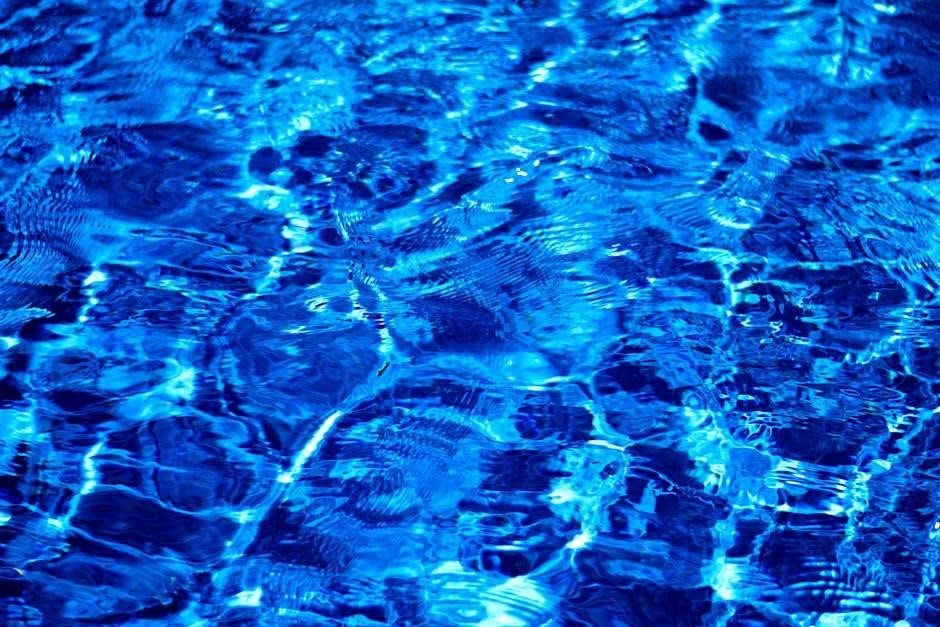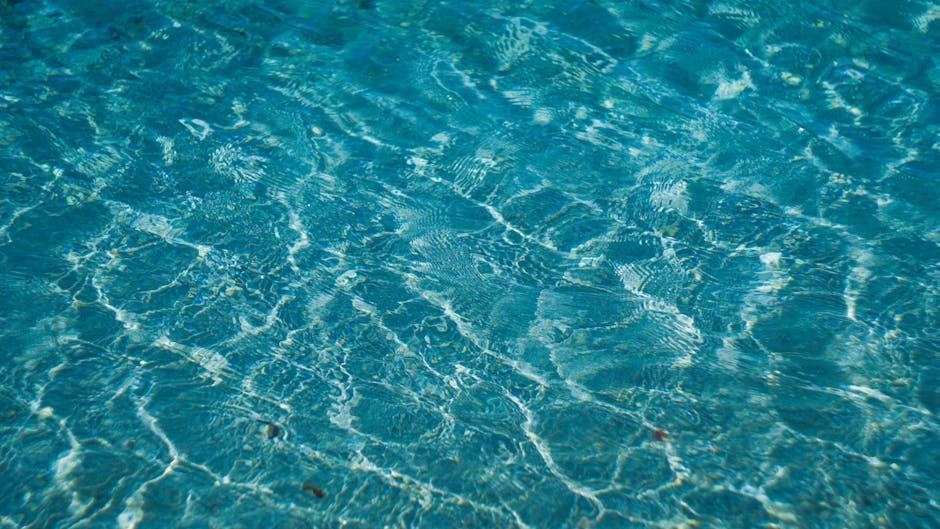An instructional pool is a specialized facility designed for teaching swimming and water safety skills. It provides a controlled environment for learners of all ages and skill levels.
1.1 Definition and Purpose
An instructional pool is a specialized swimming facility designed for teaching water-based skills and safety. Its primary purpose is to provide a safe, controlled environment for learners to develop swimming abilities, water confidence, and safety awareness. These pools are typically used in educational settings, such as schools or community centers, to offer structured lessons for individuals of all ages and skill levels.
Design and Layout of an Instructional Pool
The design and layout of an instructional pool focus on functionality, safety, and accessibility, ensuring an optimal learning environment for swimmers of all skill levels.
2.1 Key Features
Instructional pools are designed with specific features to enhance learning and safety. These include varying depths to accommodate different skill levels, shallow areas for beginners, and handrails for support. Non-slip flooring and clear visibility are essential for both instructors and learners. Additionally, adjustable water temperatures ensure comfort during sessions, making the pool accessible and user-friendly for diverse groups.
2.2 Depth and Dimensions
Instructional pools typically range in depth from 0.9 meters to 1.8 meters, allowing for gradual progression in skill development. The pool’s dimensions are designed to facilitate group learning, with lengths and widths that ensure ample space for movement and clear visibility. Shallow areas often feature a gradual slope, enabling instructors to work closely with beginners, while deeper sections accommodate more advanced techniques, ensuring a safe and effective learning environment.

Safety Measures in an Instructional Pool
Safety measures include lifeguard presence, emergency equipment, and clear pool markings. Regular inspections ensure a clean, hazard-free environment, while proper sanitation maintains water quality for safe learning.
3.1 Supervision and Emergency Procedures
Proper supervision is critical in an instructional pool. Trained lifeguards or instructors must always be present during sessions. Emergency procedures, such as rescue plans and first aid kits, should be clearly outlined and easily accessible. Regular drills ensure staff are prepared for incidents. Clear communication devices and visible emergency contact information are essential. A well-prepared environment minimizes risks and ensures a safe learning space for all participants.
3.2 Equipment and Accessories
Equipment and accessories in an instructional pool are essential for effective teaching and safety. Common tools include kickboards, pool noodles, and flotation devices, which aid in skill development. Durable and versatile equipment ensures a safe and engaging learning environment; Proper storage and maintenance of these accessories are crucial to uphold their functionality and longevity, supporting the overall instructional objectives of the pool.

Instructional Pool Programming
Instructional pool programming includes swimming lessons and water safety courses. These structured activities are designed for all ages and skill levels, promoting skill development and confidence.
4.1 Swimming Lessons
Swimming lessons are a core component of instructional pool programming. They are typically offered in group or private sessions, catering to diverse age groups and skill levels. Lessons focus on progressing from basic water adaptation to advanced stroke techniques. Instructors emphasize safety, technique, and confidence-building. Programs often include skill assessments to tailor instruction, ensuring participants achieve measurable progress and mastery of swimming fundamentals.
4.2 Water Safety Courses
Water safety courses are essential programs offered in instructional pools. These courses teach individuals how to prevent and respond to aquatic emergencies. Topics include life-saving techniques, proper use of flotation devices, and recognition of distress signals. Courses often target children, adults, and caregivers, aiming to reduce drowning risks and promote safe water practices. Many pools also offer certification programs, enhancing community safety awareness and preparedness.

Technology in Instructional Pools
Technology enhances instructional pools by improving safety and learning experiences. Advanced monitoring systems track water quality, while digital tools provide interactive lessons and real-time feedback for swimmers.
5.1 Pool Monitoring Systems
Pool monitoring systems play a crucial role in maintaining water quality and safety. These systems use sensors to track pH levels, chlorine levels, and temperature in real-time; Automated alerts notify staff of any imbalances, enabling quick adjustments to ensure a safe environment for swimmers. Advanced systems also monitor filtration efficiency and water clarity, reducing the need for manual testing. This technology helps maintain consistency and prevents potential health risks, ensuring optimal conditions for instructional activities.
5.2 Digital Learning Tools
Digital learning tools enhance instructional pool experiences by providing interactive resources. These include tutorials, virtual simulations, and AI-driven feedback systems. Tools like stroke analyzers and progress trackers help swimmers improve technique. Virtual reality simulations offer immersive water safety training. Additionally, online platforms provide accessible lesson plans and video demonstrations, catering to diverse learning styles. These technologies make learning engaging and effective, ensuring swimmers gain skills confidently and efficiently in a supportive environment.

Benefits of Using an Instructional Pool
An instructional pool offers a controlled environment for skill development, ensuring safety and effective learning. It fosters confidence and promotes water awareness, benefiting swimmers of all ages.
6.1 Skill Development
An instructional pool significantly aids in skill development by providing a structured environment for learning. It helps individuals master water acclimation, stroke techniques, and safety maneuvers. The controlled setting allows for focused practice, enhancing coordination and endurance. Instructors can tailor lessons to meet diverse needs, ensuring progress at every level. This targeted approach fosters confidence and competence, making it an ideal space for swimmers of all ages to refine their abilities effectively.
6.2 Health and Wellness
An instructional pool promotes health and wellness by offering low-impact exercises that improve cardiovascular health and strengthen muscles. Swimming reduces stress and enhances mental well-being. The buoyancy of water supports joint health, making it ideal for rehabilitation and fitness. Regular pool activities encourage a healthy lifestyle, improve circulation, and boost overall physical and mental well-being for participants of all ages and fitness levels.
Challenges in Managing an Instructional Pool
Managing an instructional pool involves balancing maintenance costs, ensuring water quality, and handling high usage. Safety, staff training, and equipment upkeep are also critical challenges to address effectively.
7.1 Maintenance Costs
Maintaining an instructional pool requires significant financial investment. Ongoing expenses include chemical treatments, filtration systems, and equipment repairs. Regular inspections and upgrades to meet safety standards also add to the costs. Additionally, energy consumption for heating and water circulation contributes to high operational expenses, making budget planning essential for sustainable pool management. These costs are crucial to ensure a safe and functional learning environment for swimmers of all levels.
7.2 Staff Training
Effective staff training is essential for managing an instructional pool. Instructors and lifeguards must undergo regular training in water safety, first aid, and emergency response. Ongoing professional development ensures they stay updated on teaching methodologies and pool safety standards. Clear communication skills are also vital to provide effective guidance to learners. Continuous training helps maintain a safe and educational environment for all pool users.
Case Studies of Successful Instructional Pools
Successful instructional pools demonstrate effective programming, safety, and community engagement, offering real-world examples of how aquatic education can thrive in various settings and populations.
8.1 Examples from Community Centers
Community centers often serve as hubs for instructional pool programs, offering accessible and affordable swimming lessons. For instance, the YMCA Knightdale pool provides day passes for families, promoting inclusivity and skill development. These centers emphasize water safety and cater to diverse populations, including children and adults. Adaptive programs for special needs individuals highlight their commitment to accessibility. Successful examples demonstrate the impact of community engagement and structured aquatic education.
8.2 School-Based Programs
School-based instructional pool programs are integral to physical education, offering students structured swimming lessons and water safety training. Teachers and trained instructors oversee these programs, ensuring a focus on skill development and safety. These programs often include progressive learning paths, allowing students to build confidence and competence in the water. Many schools integrate these pools into their health education curriculum, promoting overall wellness and lifelong aquatic skills. Successful implementations highlight the educational and health benefits for students.

Future Trends in Instructional Pool Design
Future trends include eco-friendly designs, smart technology integration, and adaptive layouts for diverse user needs, ensuring sustainability and enhanced learning experiences in instructional pool settings.
9.1 Sustainability Initiatives
Sustainability initiatives in instructional pool design focus on eco-friendly materials, energy-efficient systems, and water conservation. These practices reduce environmental impact while maintaining functionality. Solar heating, rainwater harvesting, and advanced filtration systems are increasingly adopted. Green technologies minimize chemical use, promoting healthier swimming conditions. Sustainable designs also incorporate recycled materials and energy-saving equipment, aligning with global environmental goals. These initiatives ensure instructional pools are both eco-conscious and effective for teaching purposes.
9.2 Integration with Smart Technology
Smart technology enhances instructional pool efficiency through automated systems and digital tools. Advanced pool monitoring systems track water quality, temperature, and chemical levels in real time, ensuring optimal conditions. Digital learning tools, such as interactive swim lesson apps, provide instructors with innovative teaching methods. Smart devices also enable real-time feedback for swimmers, improving technique and safety. These technologies streamline operations, making instructional pools more effective and modern learning environments.
Maintenance and Upkeep
Regular maintenance ensures the instructional pool remains safe and functional. This includes cleaning, sanitizing, and inspecting equipment to prevent issues and extend the pool’s lifespan.
10.1 Cleaning and Sanitation
Regular cleaning and sanitation are essential for maintaining a safe and healthy instructional pool environment. This includes daily disinfecting of surfaces, proper filtration systems, and monitoring water pH levels. Drain covers and pipes should be cleaned periodically to prevent contamination. Additionally, waste management systems must be efficient to ensure cleanliness and hygiene standards are consistently met.
10.2 Regular Inspections
Regular inspections are crucial for ensuring the instructional pool’s safety and functionality. Daily and weekly checks should include examining the pool floor, walls, and equipment. Monthly inspections should involve deeper assessments of pumps, filters, and plumbing systems. These inspections help identify potential issues early, preventing accidents and maintaining optimal conditions for swimming and learning. They also ensure compliance with health and safety regulations.
11.1 Summary of Key Points
An instructional pool serves as a vital educational space for teaching swimming and water safety. Its design emphasizes accessibility and safety, with features like adjustable depths and supervision areas. Programming includes swimming lessons and water safety courses, catering to diverse needs. Technology integration enhances learning and monitoring, while regular maintenance ensures a clean and safe environment. The pool fosters skill development, health, and wellness, making it an essential community resource for all ages.



